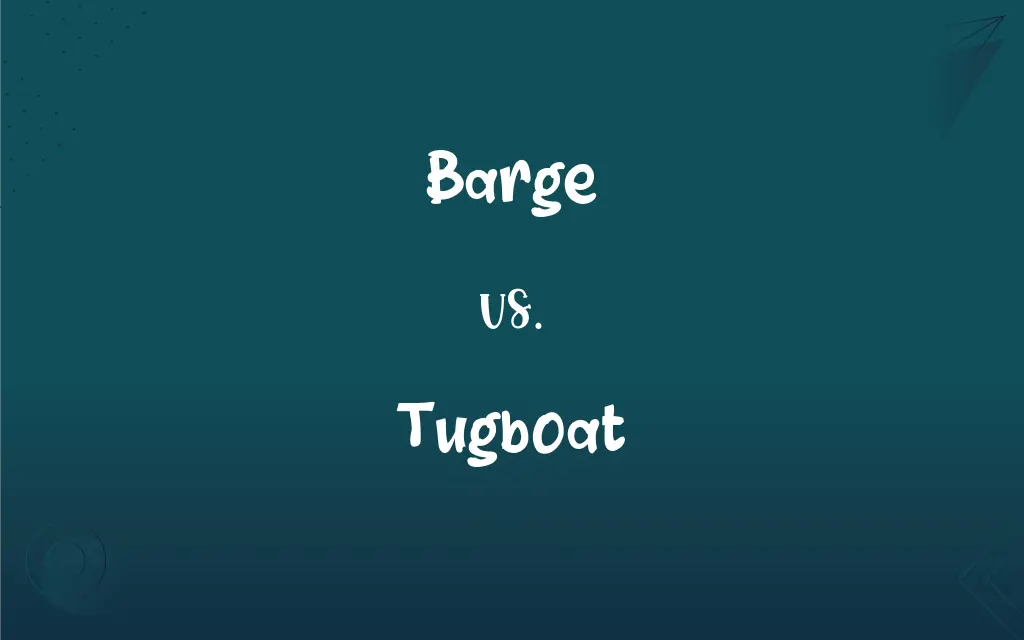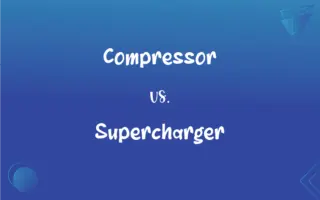Barge vs. Tugboat: What's the Difference?
By Aimie Carlson || Updated on May 30, 2024
A barge is a flat-bottomed vessel used for transporting goods on rivers and canals, while a tugboat is a small, powerful boat used to tow or push larger vessels like barges.

Key Differences
A barge is a large, flat-bottomed vessel designed for transporting goods, primarily on inland waterways like rivers and canals. Barges can carry bulk cargo such as coal, grain, and gravel. They are usually not self-propelled and require assistance from other vessels to move. A tugboat, on the other hand, is a small but powerful boat used to maneuver larger vessels by towing, pushing, or guiding them. Tugboats are essential in ports and harbors where precise navigation is required, and they often assist in moving barges, ships, and other heavy loads.
Barges are typically used for transporting heavy or bulky goods over relatively short distances on inland waterways. They offer an economical way to move large volumes of cargo but lack the capability to navigate independently. Tugboats provide the necessary power and control to move barges and other vessels, especially in tight or crowded waterways. Tugboats are equipped with strong engines and are designed for high maneuverability, allowing them to operate effectively in confined spaces. Barges, conversely, have a simple design focused on maximizing cargo space and load capacity rather than mobility or speed.
Barges serve as the cargo carriers on inland waterways, relying on external power sources for movement, whereas tugboats provide the power and maneuverability needed to move and position these larger vessels.
Comparison Chart
Primary Function
Transporting goods on waterways
Towing, pushing, and guiding vessels
Design
Flat-bottomed, large cargo capacity
Small, powerful, highly maneuverable
ADVERTISEMENT
Propulsion
Typically non-self-propelled
Self-propelled with strong engines
Common Use
Carrying bulk cargo
Assisting ships and barges in navigation
Typical Location
Inland waterways, rivers, canals
Ports, harbors, coastal areas
Barge and Tugboat Definitions
Barge
Used primarily on inland waterways.
Barges are a common sight on the canal transporting goods.
Tugboat
Equipped with strong engines for towing and pushing.
Tugboats are crucial for moving ships in and out of port.
ADVERTISEMENT
Barge
Economical for moving large volumes of cargo.
The barge system reduced transportation costs significantly.
Tugboat
A small, powerful boat for maneuvering larger vessels.
The tugboat helped the tanker navigate the harbor.
Barge
A flat-bottomed vessel for transporting goods.
The barge carried tons of coal down the river.
Tugboat
Designed for high maneuverability.
The tugboat expertly guided the barge through the narrow channel.
Barge
A large boat designed for bulk cargo.
The construction materials were loaded onto the barge.
Tugboat
Operates in ports, harbors, and coastal areas.
Tugboats are always busy in the bustling harbor.
Barge
Usually requires external propulsion.
A tugboat towed the barge to its destination.
Tugboat
Essential for precise navigation and positioning.
The tugboat positioned the cargo ship perfectly at the dock.
Barge
A long, large, usually flatbottom boat for transporting freight that is generally unpowered and towed or pushed by other craft.
Tugboat
A small powerful boat designed for towing or pushing larger vessels. Also called towboat.
Barge
A large, open pleasure boat used for parties, pageants, or formal ceremonies.
Tugboat
A small, powerful boat used to push or pull barges or to help maneuver larger vessels.
Barge
A powerboat reserved for the use of an admiral.
Tugboat
A powerful small boat designed to pull or push larger ships
Barge
To carry by barge.
Barge
To move about clumsily.
Barge
To intrude or interrupt, especially rudely
Barged into the meeting.
Barge
A large flat-bottomed towed or self-propelled boat used mainly for river and canal transport of heavy goods or bulk cargo.
Barge
A richly decorated ceremonial state vessel propelled by rowers for river processions.
Barge
A large flat-bottomed coastal trading vessel having a large spritsail and jib-headed topsail, a fore staysail and a very small mizen, and having leeboards instead of a keel.
Barge
One of the boats of a warship having fourteen oars
Barge
The wooden disk in which bread or biscuit is placed on a mess table.
Barge
(US) A double-decked passenger or freight vessel, towed by a steamboat.
Barge
A large omnibus used for excursions.
Barge
To intrude or break through, particularly in an unwelcome or clumsy manner.
Barge
(transitive) To push someone.
Barge
A pleasure boat; a vessel or boat of state, elegantly furnished and decorated.
Barge
A large, roomy boat for the conveyance of passengers or goods; as, a ship's barge; a charcoal barge.
Barge
A large boat used by flag officers.
Barge
A double-decked passenger or freight vessel, towed by a steamboat.
Barge
A large omnibus used for excursions.
Barge
A flatbottom boat for carrying heavy loads (especially on canals)
Barge
Push one's way;
She barged into the meeting room
Barge
Transport by barge on a body of water
FAQs
What is a barge used for?
A barge is used for transporting bulk goods on inland waterways like rivers and canals.
Where are tugboats commonly found?
Tugboats are commonly found in ports, harbors, and coastal areas, assisting in the navigation of larger vessels.
What types of cargo do barges typically carry?
Barges typically carry bulk cargo such as coal, grain, gravel, and construction materials.
How does a tugboat assist a barge?
A tugboat assists a barge by towing, pushing, or guiding it, providing the necessary power and maneuverability.
Are barges self-propelled?
Most barges are not self-propelled and rely on tugboats or other vessels for movement.
What is the primary design feature of a barge?
The primary design feature of a barge is its flat-bottom, which maximizes cargo capacity and stability on calm waters.
Why are tugboats important in harbors?
Tugboats are important in harbors for maneuvering large vessels in confined spaces and ensuring safe docking and navigation.
What makes tugboats highly maneuverable?
Tugboats have powerful engines and a compact design, allowing them to navigate precisely in tight or crowded areas.
Do barges travel on the open sea?
Barges are primarily used on inland waterways and are not typically designed for open sea travel.
What are the economic benefits of using barges?
Barges provide an economical way to transport large volumes of goods, reducing transportation costs compared to other methods.
How do tugboats contribute to maritime safety?
Tugboats contribute to maritime safety by ensuring that large vessels are properly maneuvered and positioned, preventing accidents in crowded or confined waterways.
How are tugboats designed for their role?
Tugboats are designed with powerful engines and high maneuverability to effectively tow and push larger vessels.
What is the lifespan of a typical barge?
The lifespan of a typical barge can vary but generally ranges from 20 to 50 years, depending on maintenance and usage.
Do tugboats require special crew training?
Yes, operating a tugboat requires specialized training for the crew to handle the vessel's power and maneuverability effectively.
Can a barge operate on its own?
Generally, a barge cannot operate on its own and needs a tugboat or another vessel to move it.
What industries rely heavily on barges?
Industries such as construction, agriculture, and mining rely heavily on barges for transporting bulk materials.
Are tugboats used in rescue operations?
Yes, tugboats can be used in rescue operations to assist distressed vessels and ensure safe navigation.
What kind of engines do tugboats have?
Tugboats are equipped with strong, durable engines designed to generate significant power for towing and pushing.
Can tugboats operate in rough seas?
Tugboats are built to handle various water conditions, including rough seas, although they primarily operate in more protected areas.
How do barges impact the environment?
Barges are considered an environmentally friendly transportation method, as they produce lower emissions per ton of cargo compared to trucks or trains.
About Author
Written by
Aimie CarlsonAimie Carlson, holding a master's degree in English literature, is a fervent English language enthusiast. She lends her writing talents to Difference Wiki, a prominent website that specializes in comparisons, offering readers insightful analyses that both captivate and inform.































































